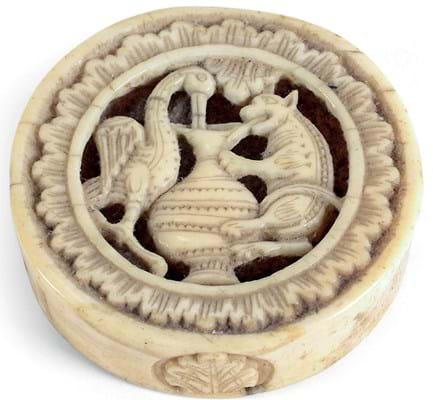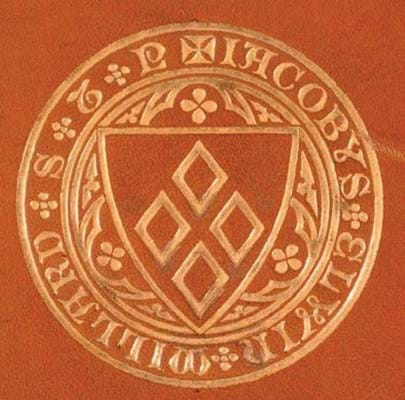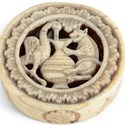Measuring 2¼in (5.75cm) wide, it is carved in high relief with a scene from the fable of The Fox and the Stork within a foliate border. To the side are four small leafy medallions.
Estimated at £15,000-20,000 at the sale on January 14, it sold for the highest price of the day at £40,000 (plus 25% buyer’s premium) to a Continental European dealer.
The game of tables or backgammon, played with 15 counters on each side, was popular among the nobility throughout northern Europe in the 11th and 12th centuries. Gaming boards were taken on the Crusades: examples with bone sections have been excavated at Saint-Denis and in Gloucester where a complete tabula set was unearthed on the site of a Norman castle in 1983.
As supplies of elephant ivory largely ceased after the Muslim conquests, most were made from walrus ivory. A number of carving centres have been identified including those in Cologne, northern France and St Albans.
Today about 250 Romanesque tablemen with figurative designs survive displaying a range of religious, secular and mythical subject-matter.
This piece, dated to c.1150-80, must have belonged to a set of tablemen with scenes from Aesop’s Fables.
The carving shows the moment of the stork’s revenge. After the fox had served soup in a bowl from which the bird could not drink, the stork offers its guest a meal in a narrow-necked vessel. The moral is clear: do to others what one would wish for oneself.
Latin translation of stories from the Aesopic canon were common in the Middle Ages.
However, this is thought to be among the earliest depictions of this particular tale – contemporary with Romanesque carving to one of the columns of the cloisters in the Collegiata di Sant’Orso in Aosta.
Medieval walrus ivories such as this – made at the same time as the Lewis chessmen – were the stuff of ‘cabinets of curiosity’ from the 17th century onwards.
It came for sale by descent from Rev Dr James Elwin Millard (1823-94) of Magdalen College, Oxford, in whose collection this piece was recorded in 1873. A bespoke box carries his name and arms. It was the same source as a 17th century amber and silver gilt chalice sold by the auctioneers in 2011 for £210,000.
Specialist Anthony Kilroy quickly learned from the V&A that a cast of the tableman had formed part of John Obadiah Westwood’s 1876 publication A Descriptive Catalogue of the Fictile Ivories in the South Kensington Museum. When pictured again as part of Adolph Goldschmidt’s monumental work on early medieval ivories, its whereabouts were described as ‘lost’. The cast is still in the V&A’s collection and available to view online.


















